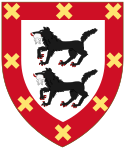Diego López I de Haro facts for kids
Quick facts for kids
Diego López I de Haro
|
|
|---|---|

Coat of arms of the House of Haro
|
|
| Died | 1124 |
| Noble family | Haro |
| Spouse(s) | María Sánchez |
| Father | Lope Íñiguez |
| Mother | Ticlo (Tecla) Díaz |
Diego López I de Haro was an important leader in Spain during the early 1100s. He was the third Lord of Biscay, a powerful region in what is now the Basque Country. He also ruled over other areas like Álava, Nájera, and Haro. He was one of the strongest noblemen in the Kingdom of Castile at that time.
Diego was a very loyal supporter of Queen Urraca. He bravely fought against the armies of her husband, Alfonso the Battler, who was trying to take control of her lands.
Contents
Becoming a Powerful Lord
Taking Over Lands
Diego López I became the Lord of Biscay in 1093 after his father, Lope Íñiguez, passed away. He also took control of Guipúzcoa. However, another region called Álava went to his brother-in-law, Lope González.
Later, in 1108, a nobleman named García Ordóñez died in a battle. This allowed Diego to gain control of more important areas like Grañón, Nájera, and Haro. These lands were given to him by King Alfonso VI.
Gaining Special Rights
In 1110, Queen Urraca gave Diego special rights for his family lands. This meant his lands could not be taken away by the crown. This was a big deal because it showed how much she trusted him.
Around the same time, Diego was called "senior in Nagera," meaning he was the main leader there. After Lope González died, Diego also took over Álava, bringing all his father's lands back together. Diego was the first in his family to use "de Haro" as a family name, which became very famous.
Loyalty and Battles
Fighting for Queen Urraca
Diego was a strong supporter of Queen Urraca, even when she was having problems with her husband, Alfonso the Battler. Their lands were close to each other, which often led to conflicts.
In 1116, Diego rebelled against Alfonso. Because of this, he lost control of Nájera, which was given to someone else. But he was allowed to keep Haro and Buradón.
Working with Alfonso
Even though they fought, Diego and Alfonso sometimes worked together. In 1118, Diego helped Alfonso in a major battle to conquer the city of Zaragoza. He continued to help in the conquest of the surrounding areas in 1119.
Final Conflict and Death
In 1124, Diego, possibly encouraged by Queen Urraca or her son, Alfonso VII, rebelled against Alfonso the Battler again. Alfonso himself led an army to besiege Diego in Haro.
Diego lost all his lands and titles during this time. Historians are not sure exactly when he died. Some say he died in 1124 during the fighting, while others believe he passed away in 1126 after losing everything.
Family Life
Diego López I de Haro married a woman named María Sánchez. Not much is known about her family.
They had four sons:
- Lope Díaz I, who later became the Lord of Biscay and Álava, just like his father.
- Sancho
- Fortunio
- Gil
Diego's family, the House of Haro, became one of the most important noble families in the history of Spain.
| Preceded by Lope Íñiguez |
Lord of Biscay 1093–1124 |
Succeeded by Íñigo Vélaz |
See also
 In Spanish: Diego López I de Haro para niños
In Spanish: Diego López I de Haro para niños

